When we think of sea animals with shells, common names that come to mind are shrimp, snails, and crabs. However, many more sea creatures have shells, and the list is too long to count. Most of them belong to the same family. In this article, I will discuss 20 sea animals with shells that you may not have known.
20 Sea Animals With Shells
Let’s know about the 20 sea animals that actually have shells. But first, look at the chart.
| Sea Animals With Shells | Interesting Fact |
| Abalone | Abalones are a type of snail that can live up to 40 years. |
| American Lobsters | American lobsters have a longer lifespan than most animals, with some living over 100 years. |
| Barnacles | Barnacles are the only crustaceans that are exclusively sessile, meaning they spend their entire lives attached to a surface. |
| Chitons | Chitons have a flexible shell that allows them to curl up into a ball when threatened. |
| Clams | Clams have a muscular foot that they use to burrow into sand or mud. |
| Cockscomb Oysters | Cockscomb oysters get their name from the wavy, comb-like appearance of their shells. |
| Conch | The shell of a conch can be used as a musical instrument. |
| Cowries | Cowries have been used as currency in many cultures throughout history. |
| Ghost Shrimp | Ghost shrimp are transparent and can regenerate their limbs. |
| Japanese Spider Crabs | Japanese spider crabs are the largest arthropods in the world, with legs that can span up to 12 feet. |
| Krill | Krill are a vital part of the marine food chain and can form massive swarms that are visible from space. |
| Mussels | Mussels attach themselves to rocks and other surfaces using strong threads called byssal threads. |
| Nautilus | Nautiluses are the only cephalopods with an external shell, which they use for buoyancy control. |
| Oysters | Oysters can change their gender multiple times throughout their lifespan. |
| Pistol Shrimps | Pistol shrimps produce a very loud sound that can break a glass. |
| Sand Dollars | Sand dollars are flattened sea urchins that burrow into sand and feed on tiny particles of food. |
| Scallops | Scallops have dozens of small, bright blue eyes that allow them to sense light and movement. |
| Slipper Shells | Slipper shells are named for their unique shape, which resembles a slipper or shoe. |
| Top Snails | Top snails have shells that are brightly colored and patterned, making them popular with shell collectors. |
| Whelks | Whelks are predatory sea snails that use their radula, a ribbon-like structure covered in tiny teeth, to scrape food off rocks. |
Abalone
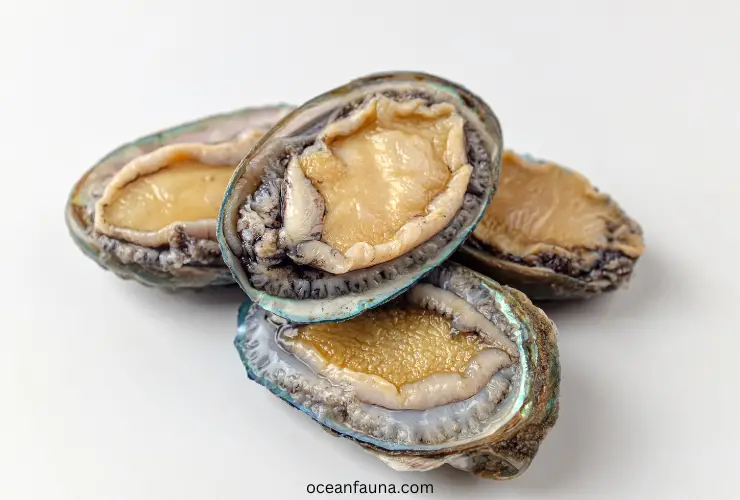
As a member of the Haliotidae family, the Abalone (Haliotis) is a unique and fascinating marine invertebrate that is highly valued for its flesh and decorative shell.
The Abalone shell is arguably one of the most striking features of this creature. The shell is characterized by an asymmetrical, ear-like shape and a series of small holes or perforations used as respiratory openings.
One of the most notable aspects of the Abalone shell is the colorful and iridescent inner layer, also known as the nacreous layer. This layer is responsible for the shell’s remarkable luminescence and the unique and iconic designs that have made Abalone shells highly sought after for use in jewelry and decoration.
American Lobsters
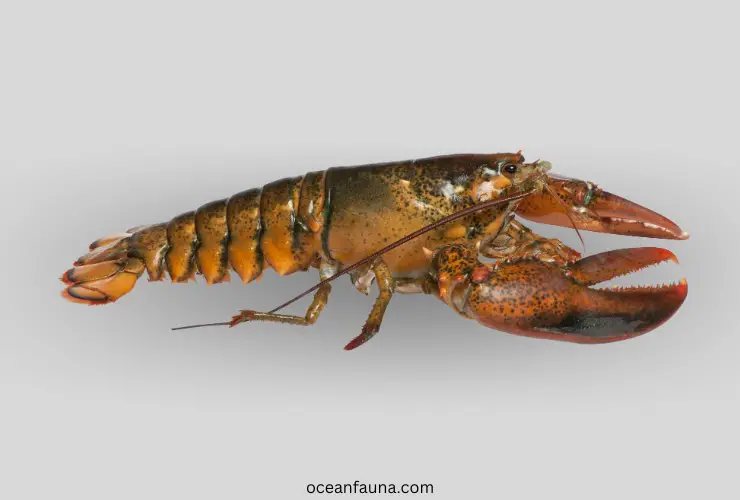
American Lobsters (Homarus americanus) are a species of crustacean that is highly sought after in the seafood industry for their succulent meat. Their shell is renowned for its unique features that protect them from predators and ensure their survival in their natural habitats.
The shell of American Lobsters is composed of chitin, a hard, protective material that covers their entire body. This shell provides excellent protection against predators and can absorb significant impact without breaking. Interestingly, as the lobster grows, the old shell must be shed in a process known as molting, allowing the lobster to grow into a larger shell.
Barnacles
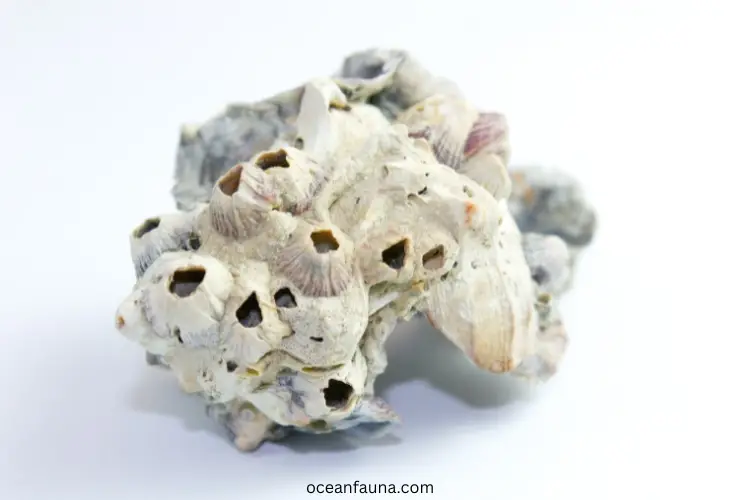
Barnacles (Cirripedia) are known for their unique anatomy, particularly their strong and durable calcareous shells. These shells are composed of several plates, which vary in number and size depending on the species and are tightly cemented together to form a hard, protective covering.
The body of a barnacle is divided into two parts: the carapace, which is the part covered by the shell, and the thorax, which contains the appendages, mouthparts, and reproductive organs.
The appendages or cirri are long, slender structures that are used for feeding and respiration. They are covered in fine hairs called setae, which filter out particles from the water and allow the barnacle to feed. The mouthparts, located at the base of the cirri, comprise a mandible and two pairs of maxillae, which are used to break down and ingest food.
Chitons
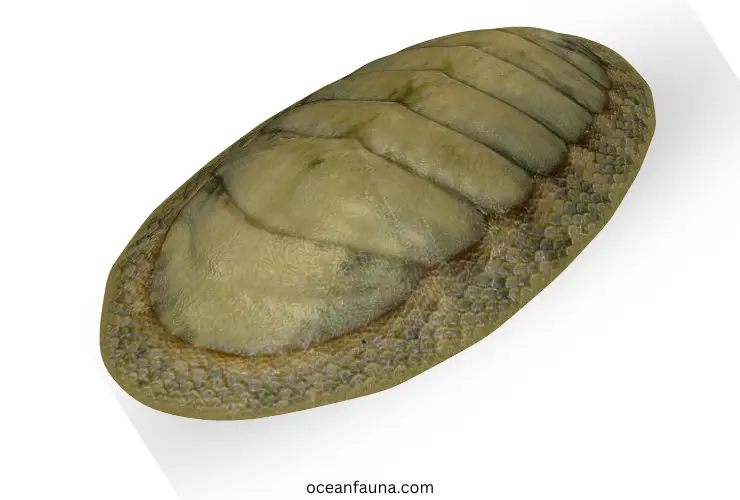
Chitons, scientifically known as Polyplacophora, are a group of marine mollusks with distinctive anatomy. Their body is elongated and flattened, with a broad foot for movement and a mantle covering their dorsal surface.
Chitons are covered by an articulated shell composed of eight dorsal plates, which overlap like roof tiles and provide protection against predators and environmental stresses.
The shell plates are held together by a series of girdle muscles that allow the chiton to roll up into a ball when threatened. Additionally, the chiton’s shell is embedded with numerous “eyes” or photoreceptors that are sensitive to light and may be involved in detecting movement or changes in light intensity.
Beyond their unique shell, chitons have a complex internal anatomy. They have a well-developed circulatory and nervous system, with a series of ganglia that respond to stimuli and regulate movement and feeding behaviors. Chitons also possess a radula, a toothed ribbon-like structure used for scraping algae off rocks and other hard surfaces.
Clams
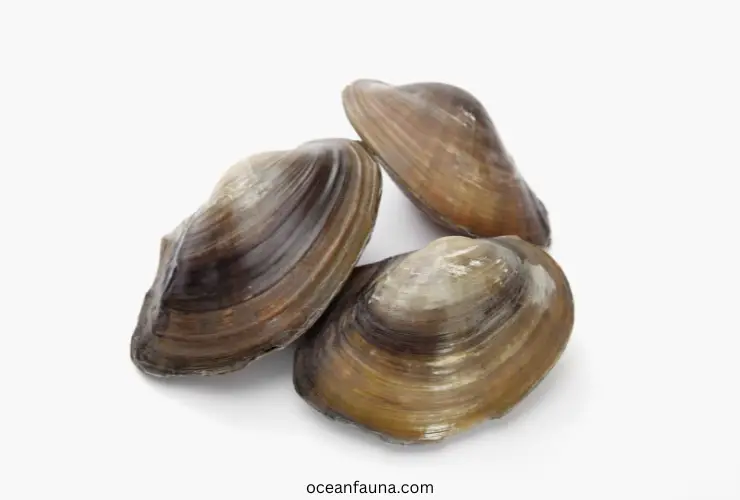
Clams are bivalve mollusks with distinctive shells that protect their soft, fleshy bodies. The shell comprises two halves, or valves, that are connected by a hinge. The shell’s exterior can range in color from shades of brown to black and may feature distinct patterns or ridges.
The shell’s interior is lined with a layer of nacre, or mother-of-pearl, that gives it a smooth, iridescent appearance. This layer also protects the clam’s delicate body and helps it to resist damage from predators or environmental factors.
Inside the shell, the clam’s body is divided into three main sections: the foot, the mantle, and the visceral mass. The foot is a muscular appendage used for movement and burrowing.
The mantle is a thin layer of tissue that surrounds the body and secretes the shell material. The visceral mass contains the clam’s organs, including its digestive, respiratory, and reproductive systems.
Cockscomb Oysters
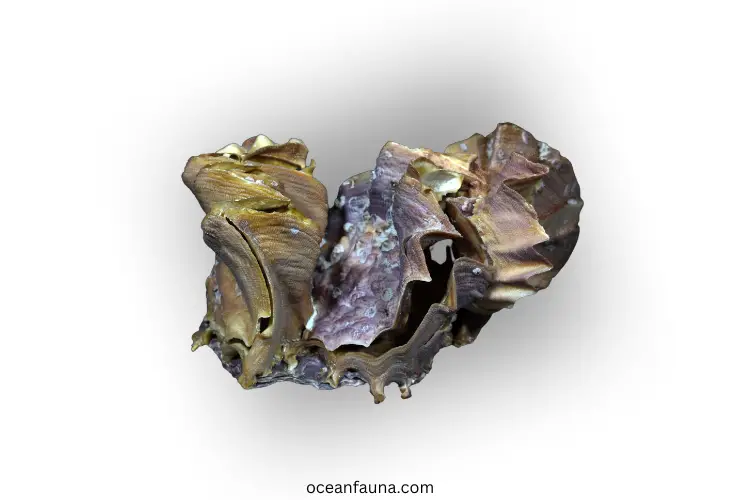
The Cockscomb Oysters, scientifically known as Lopha cristagalli, have a robust and oval-shaped shell with a characteristic cock’s comb-like wrinkled texture. The shell’s exterior is smooth and shining. Its coloration ranges from light brownish-yellow to dark grayish-brown with streaks of black or white.
The shell’s interior is pearly white, and its composition is primarily made up of calcium carbonate, making them highly durable and resistant to external factors such as predators or harsh environmental conditions.
The Cockscomb Oysters’ anatomy consists of two hinged hard shells that protect soft, fleshy tissues inside, responsible for performing essential functions such as filtering water and absorbing nutrients.
These delicate tissues are highly sensitive to changes in water chemistry, temperature, and pollution, making them highly vulnerable to habitat degradation and human activities.
Conch
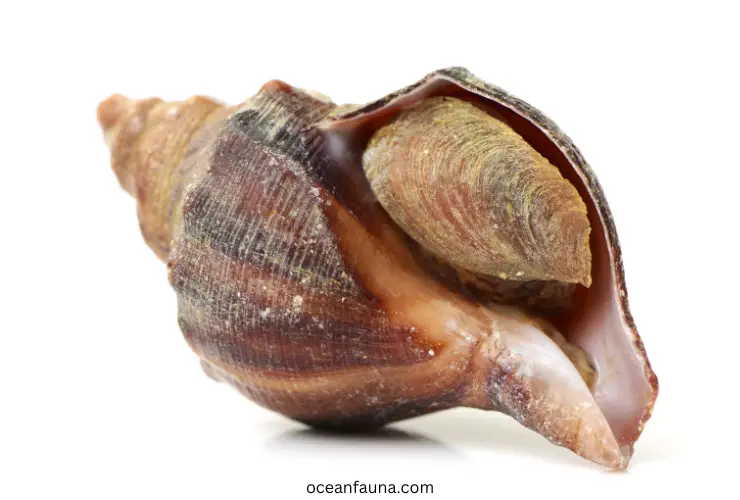
Conch (Strombus) is a type of marine snail that is commonly found in tropical waters. The anatomy of the conch is complex and fascinating, and its shell is a defining characteristic of this species.
The shell of the conch is spiral in shape and has a distinctive pointed tip called the spire. The shell comprises individual segments, or whorls, that grow as they coil around the spire. The shell is generally light in color with brownish-orange markings and a glossy finish.
The shell also serves as a protective armor against predators and helps the conch regulate its buoyancy.
Cowries
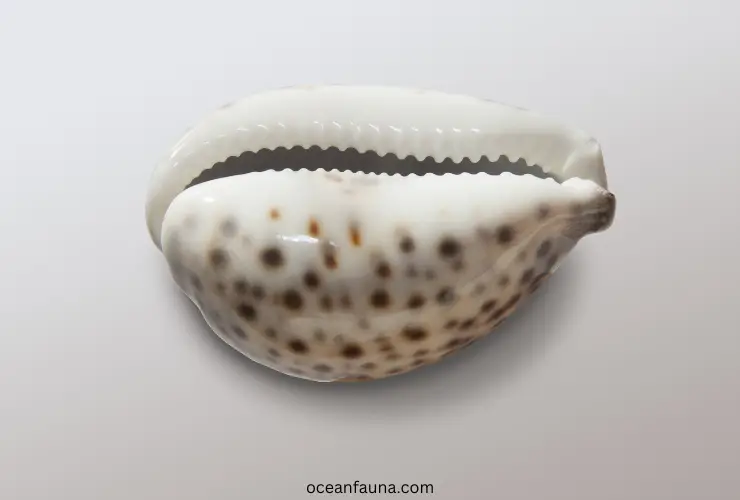
Cowries (Cypraeidae) are a family of marine gastropod mollusks that are famous for their stunningly beautiful and intricately patterned shells. These shells have served as currency, ornaments, and even religious symbols for various cultures throughout history.
However, beyond their aesthetic appeal, cowries possess a fascinating anatomy that is worth exploring in detail.
The cowrie shell is a vital component of its anatomy, as it provides protection and enables the organism to maintain its buoyancy and move efficiently through the water. The shell is typically ovate or cylindrical, with a glossy surface marked by intricate patterns, colors, and textures.
These patterns vary significantly between cowrie species, with some featuring smooth, solid-colored shells while others display a more intricate, spotted, or dotted pattern.
The shell comprises two distinct layers: an outer layer, the periostracum, and an inner layer, the prismatic layer. The outer layer is a thin, proteinaceous film that covers the shell’s surface and provides protection against abrasion and corrosion by water.
On the other hand, the inner layer is primarily made up of calcium carbonate crystals arranged in a complex matrix that gives the shell its characteristic strength and texture.
Ghost Shrimp
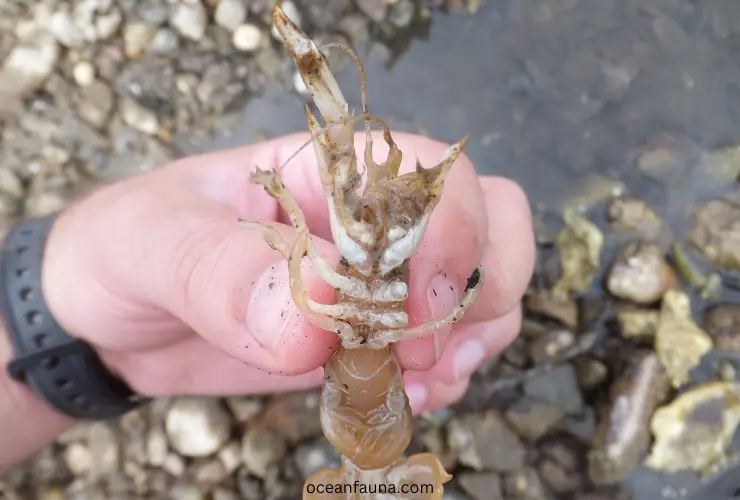
The Ghost Shrimp, also known as Palaemonetes paludosus, is a species of freshwater shrimp commonly found in North America’s eastern regions. The Ghost Shrimp boasts a unique anatomy, which allows it to adapt to its aquatic environments.
One aspect of its anatomy is its shell, which serves as a protective covering for its soft and vulnerable body. The shell of the Ghost Shrimp is thin and transparent, allowing for easy observation of its internal organs. Its shell consists of two halves, known as the carapace and the abdomen.
The carapace, which is the larger of the two halves, covers the entire anterior portion of the Ghost Shrimp’s body. Its surface is covered in fine, hair-like fibers known as setae, which allow the shrimp to sense its environment and navigate its surroundings.
The carapace is also equipped with a pair of large, compound eyes, which provide the Ghost Shrimp with excellent visual acuity both above and below water.
Conversely, the abdomen is the smaller of the two halves and is located near the posterior end of the Ghost Shrimp’s body. The abdomen is a flexible, moveable section of the shrimp that allows it to move through the water easily. The abdomen is composed of a series of segments, each of which is connected by a flexible joint.
Japanese Spider Crabs
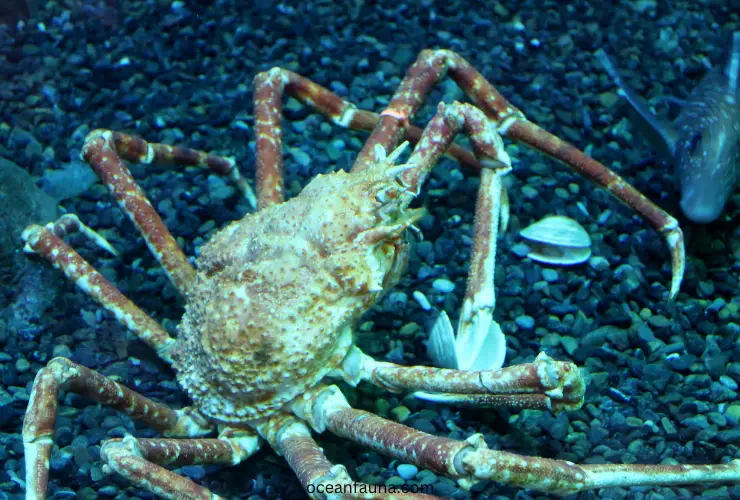
Japanese Spider Crabs, known scientifically as Macrocheira kaempferi, are arthropods belonging to the Brachyura infraorder. They are the largest species of crab in the world, with a leg span of up to 12 feet and a carapace that can measure up to 12 inches in width.
The anatomy of the Japanese Spider Crab is highly specialized and uniquely adapted to its environment. Its body is covered in a hard exoskeleton or shell, which provides protection from predators and physical damage. The shell is composed of chitin, a tough polysaccharide material also found in other arthropod shells.
The carapace or upper shell of the Japanese Spider Crab is broad and flat, with a reddish-brown coloration that helps it blend in with seaweed and rocks on the ocean floor. The carapace is also covered in small spines and bumps, which help to deter predators and provide friction for burrowing and crawling.
Krill
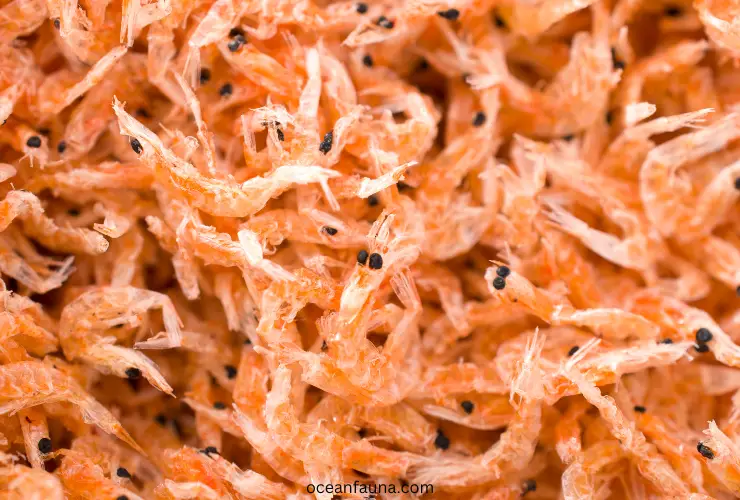
Krill (Euphausiacea) are small crustaceans belonging to the order Euphausiacea, and they play crucial roles in marine ecosystems as a primary source of food for many marine animals, including whales, penguins, and seals. Anatomically, krill have a segmented body that is divided into three major regions: the cephalothorax, abdomen, and telson.
The krill’s cephalothorax is made up of the head and thorax fused together, and it contains several appendages, including five pairs of legs and two pairs of antennae.
The legs are designed for swimming and help propel krill through the water, while the antennae are used for sensory purposes, detecting changes in temperature, salinity, and the presence of predators.
Krill also possess a unique protective exoskeleton, known as a shell or carapace, which covers their entire body, providing both physical protection and structural support. The shell of krill is composed primarily of chitin, a complex polysaccharide that is also found in the shells of other crustaceans such as lobsters and shrimp.
Krill’s shell is not a solid structure but rather porous, allowing water to circulate through the body to facilitate respiration, circulation, and excretion. The shell also grows with the body, and as krill grow, they shed their old shell and replace it with a newer one in a process known as molting.
Mussels
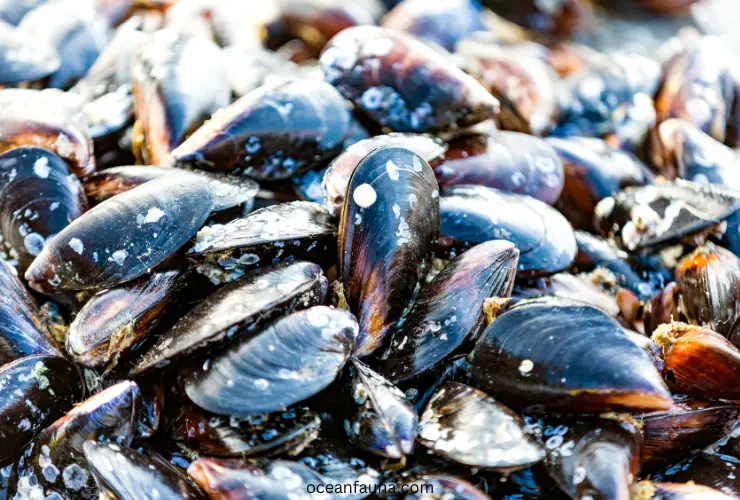
Mussels (Mytilus) are prominent in the aquatic ecosystem and are valued for their economic and culinary significance. Their anatomy is characterized by the presence of two asymmetrical shells, which are hinged and provide a protective covering for the soft inner body parts.
The shells of mussels are composed of two calcium carbonate layers, also known as periostracum and nacre. The outer layer, periostracum, is a tough, leathery coat that protects the inner shell from mechanical damage and erosion.
The nacreous layer is a shiny and iridescent layer that provides the shell with its aesthetic appearance.
Nautilus
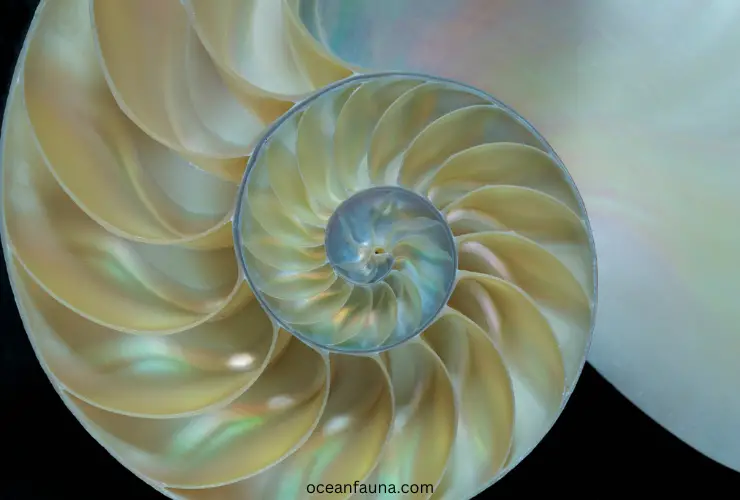
Nautilus (Nautilidae) are cephalopods, part of a group of animals, including squids and octopuses.
The shell of the nautilus is one of its defining features. It is coiled and spiraled and comprises a series of chambers that the animal can fill with gas to regulate its buoyancy. This allows the nautilus to easily move up and down in the water column.
Its shell is also notable for its beauty. It is often marked with intricate geometric patterns in brown, white, and black shades. These patterns are caused by the way that the shell grows, with new layers adding to the existing ones in a regular, repeating pattern.
Oysters
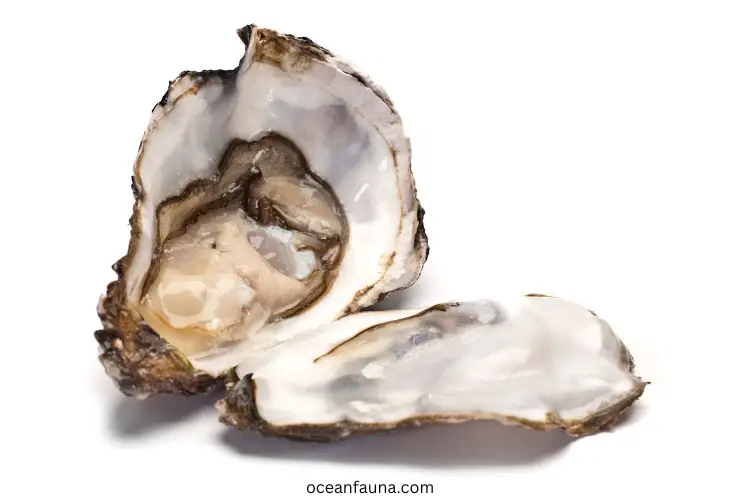
A bivalve mollusk known as an oyster (Ostreidae) has distinct anatomy, particularly its shell, which is made up of two main layers – the periostracum on the outer layer and the nacreous layer on the inner side.
The periostracum layer is the outermost layer and is made up of a tough and resilient protein known as conchiolin. This layer protects the shell from physical damage and erosion caused by harsh environmental factors, such as waves and predators.
Additionally, it gives the shell a characteristic dark or brownish color and contains various organic compounds, such as pigments and amino acids.
On the other hand, the innermost layer of the shell is called the nacreous layer. It is made up of parallel sheets of calcium carbonate crystals and gives the shell its shiny and pearly look by reflecting light. In addition to that, it provides strength and durability to the shell.
Pistol Shrimps
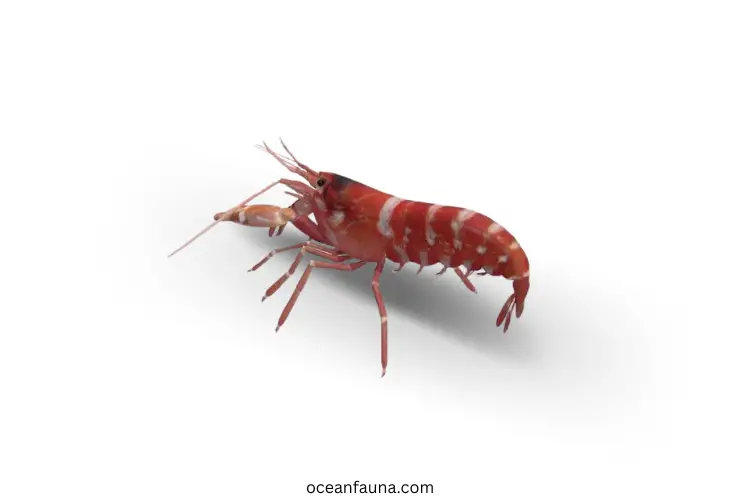
The Pistol Shrimps, also known as Alpheidae, are a fascinating group of marine crustaceans with unique and complex anatomical features. One particularly notable feature is their asymmetrical claws, which are used to create loud snapping noises that stun prey and intimidate predators.
Aside from their powerful snapping appendages, Pistol Shrimps also possess a hard protective shell known as a carapace. This carapace serves as a housing for the shrimp’s vital internal organs, including the heart, digestive system, and reproductive organs.
The carapace of Pistol Shrimps is typically made of chitin, a tough and durable substance that protects the organism from physical trauma and environmental stress. In addition to providing structural support and protection, the carapace also helps regulate the shrimp’s internal water balance and serves as a site for muscle attachment.
Sand Dollars
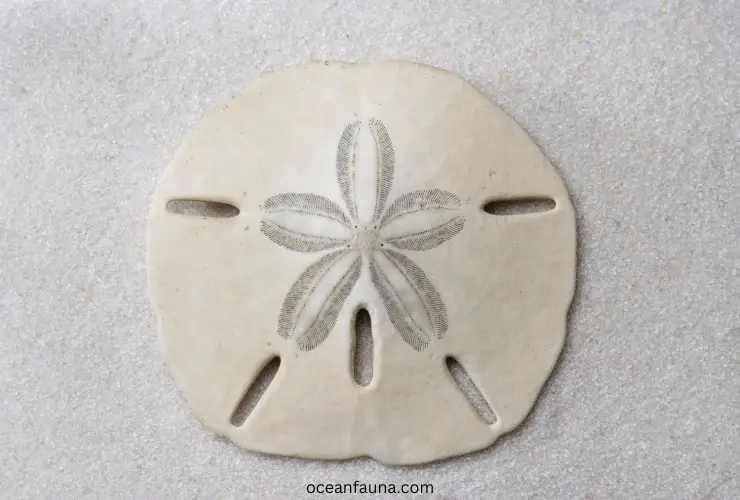
Sand dollars (Clypeasteroida) are a type of flattened burrowing sea urchin commonly found along sandy seafloors worldwide. These echinoderms have a distinctive round flat shape and unique skeletal structures.
The anatomy of sand dollars revolves around their shell, which is also referred to as their test. The shell is composed of calcium carbonate plates arranged in radial symmetry, forming five distinct segments or petals. These petals meet in the center of the shell, where the sand dollar’s mouth is located.
The petal-like segments of the shell are covered in tiny holes, known as perforations, which allow water to flow in and out of the shell. This enables the sand dollar to breathe, transport nutrients, and release waste.
In addition to the perforations, the shell also contains a set of tube feet, which the sand dollar uses to move and capture food.
The shell’s outer surface is covered in small spines, which serve as a protective mechanism against predators. The spines also provide traction for sand dollars to burrow into the sand and camouflage themselves from potential threats.
Scallops
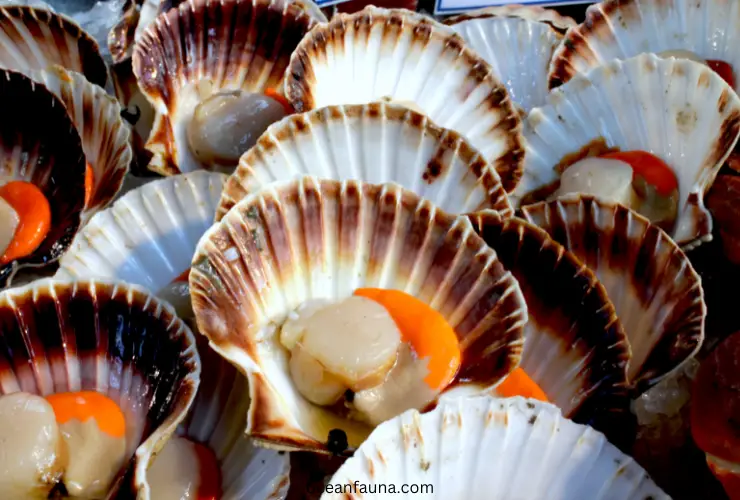
Scallops (Pectinidae) are bivalve mollusks with a unique anatomy that allows them to swim quickly in short bursts and efficiently filter feed.
The shell of a scallop is composed of two valves, the upper valve or “carapace” and the lower valve or “valve.” The carapace is generally more convex and concave, while the valve is flat.
An elastic ligament holds both valves together at the hinge, providing the shell’s mobility. The valves are covered with commarginal and radial ridges, which are growth lines that indicate the scallop’s age.
Slipper Shells
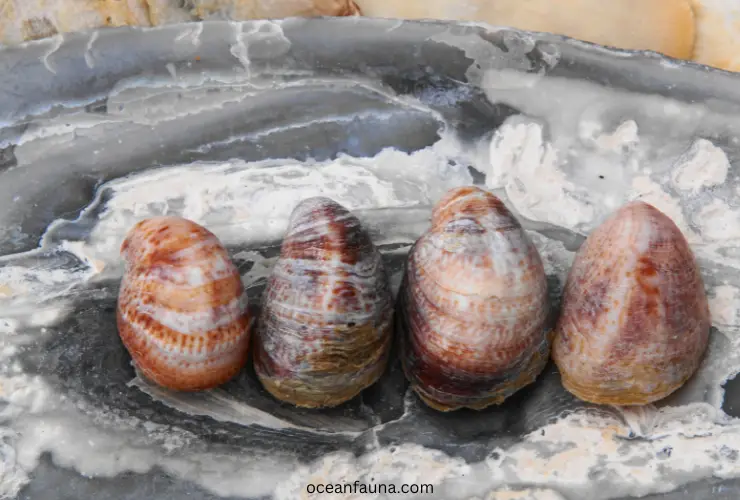
Slipper Shells (Crepidula fornicata) are a species of marine gastropod mollusk that are commonly found in the Atlantic Ocean, especially along the East Coast of North America.
The anatomy of these mollusks is characterized by their shell, which is typically oval-shaped with a flattened base and a curved upper surface. The shell is made of calcium carbonate and is typically decorated with a series of ridges and bumps, which can help distinguish between different species.
Slipper Shells have a well-developed foot that is used for locomotion and for anchoring themselves to hard surfaces such as rocks or other shells. Their foot is also used for burrowing into soft sediments, where they can hide from predators or seek out food.
Additionally, Slipper Shells have a mantle that secretes the shell and covers the animal’s soft tissues. They also have a radula, which is a toothed tongue-like organ that is used for scraping food off of surfaces.
Top Snails
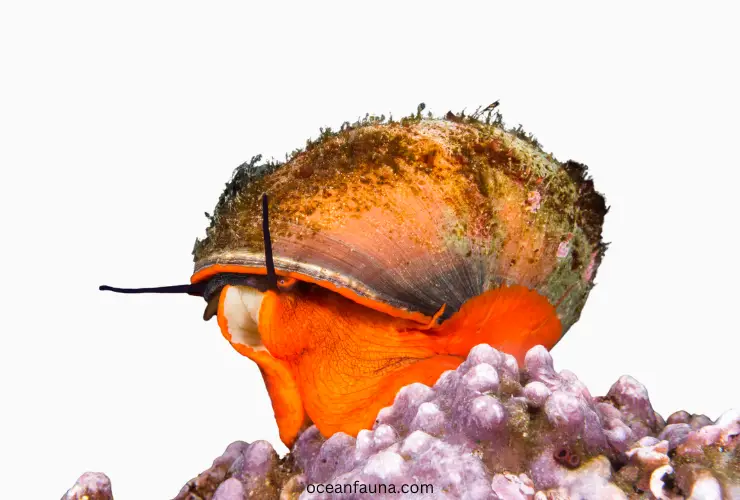
Top snails, also known as Trochidae, are a species of marine snails that are characterized by their distinctive conical shells with spiraled ridges. These shells serve as a natural protective barrier against predation and harsh environmental conditions.
The shell is made of calcium carbonate and grows continuously throughout its life. As the snail grows, new shell layers are added to the existing structure.
The spiral ridges and grooves that run along the length of the shell are important not only for protection but also for allowing air to flow over the gills and into the respiratory system.
Interestingly, the color and pattern of the shell can vary widely between species and even between individuals. Some species have bright and intricate patterns, while others are more subdued in coloration.
Some even have the ability to change the color and pattern of their shells based on their surroundings, a process known as “camouflage.”
Whelks
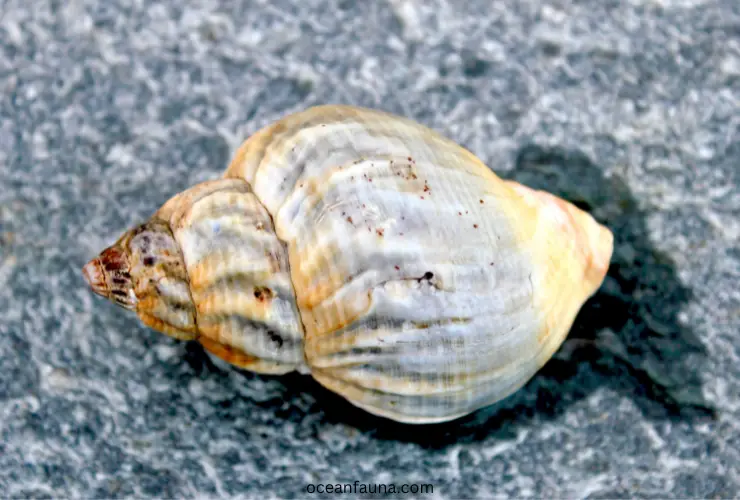
Whelks (Buccinidae) is a species of marine snail that is widely distributed across the world’s oceans. These creatures are highly valued for their culinary uses and are also harvested for their shells, which are used for decorative purposes.
Anatomy-wise, whelks have a distinctive spiral shell that protects their soft parts. Interestingly, the shell is cone-shaped. It has a pointed apex and a broad base that gradually tapers towards the opening. The shell’s surface is smooth and polished, with a glossy appearance.
The whelk’s soft body is laid out in a typical gastropod fashion within the shell. It is an elongated structure that is divided into three regions – the head, visceral mass, and muscular foot. The head bears a pair of sensory tentacles equipped with eyes and chemosensory organs that help the whelk to locate food and detect danger.
Conclusion
Now, I hope that you have a compact knowledge of these 20 sea animals with shells. Their shells have a huge impact on their survival in the habitat. Also, each sea creature species has unique and interesting shells that help them recognize easily.
So, explore the ocean and find out how many shells you can identify. If you know some more of the fish who actually have shells, let me know.

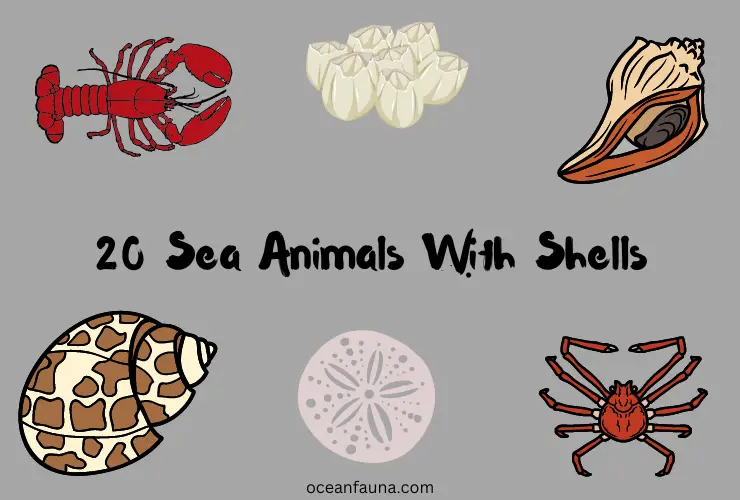
1 thought on “20 Sea Animals With Shells [Explained]”